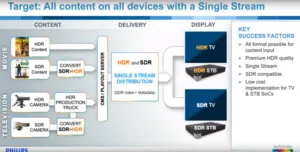Technicolor held a press lunch event to talk about its technology. Unfortunately, the event was attended by more press than expected, so the room was rather more dispersed than might have been hoped, which made it difficult to hear all the discussion. Despite the moderator’s attempts to widen the discussion, much of it centred on the Philips/Technicolor technology around HDR. We didn’t get much from the event that wasn’t covered in our report from the visit to Technicolor earlier this year. (Plenty to See from Technicolor in Rennes).

We met with Technicolor, additionally, to talk about the developments in HDR. The company still believes it has an alternative to HLG and HDR10/Dolby/PQ, but, realistically, now that BT2100 is out, the emphasis for the company has changed to promoting its technology for the delivery of HDR and SDR content and the translation of one to the other. The technology can work whether the content is encoded as SDR or with the PQ curve. It can also support the Sony SLog3 curve.
Philips and Technicolor point out that nearly all the UltraHD sets in the field and likely to be installed this year will be SDR, rather than HDR, so it is really important that HDR content is made backward compatible with these sets. Further, in the future, there will be a much wider range of capabilities in brightness and colour in TVs than we have seen before. The Techicolor/Philips solution takes HDR signals (whether using HLG or the PQ curve) and converting this to an SDR-compatible stream, with the data needed to convert the stream to HDR contained in metadata in the SDR stream.
A compatible TV can use the metadata to convert back to HDR, but one which doesn’t know what to do with the metadata simply shows the SDR image. That keeps all the data in a single, compatible stream, a big advantage to broadcasters. Whereas an HDR10 content stream will not be understood by an older SDR set, with the Philips/Technicolor approach, this is not a problem.
The Technicolor approach has been standardised as ETSI SL-HDR-1 dated August 2016 and uses SEI messaging in the HEVC stream, staff told us.
Cable and Satellite International Magazine gave Technicolor an award for the “Best Video Processing” and the company also had boxes based on Broadcom, Marvell and MStar SoCs on show that use its technology. It told us that it has SoCs (including private, non-merchant chips) with support for the technology.
Analyst Comment
The solution that Technicolor is proposing is elegant and efficient and meets a wide range of different situations. It allows good SDR and HDR at the same time from a single stream and both companies have demonstrated that the solution is better in some situations than other solutions, such as HLG. However, broadcasters are very negative about the whole concept of metadata, so it remains to be seen whether they will be willing to adopt this solution. (BR)

